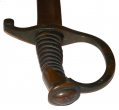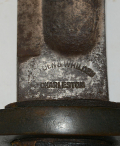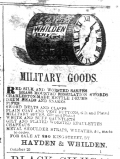site search
online catalog
VERY SCARCE CONFEDERATE “HAYDEN & WHILDEN / CHARLESTON” MARKED SOUTH CAROLINA LIGHT ARTILLERY SABER WITH BRASS SCABBARD

$15,000.00 ON HOLD
Quantity Available: 1
Item Code: 870-616
“Brass mounted regulation swords” are specifically listed among the military goods offered for sale by Hayden and Whilden of Charleston, SC, in an October 1861 advertisement. The firm was organized in 1855, but had a long history in the city in various permutations of partnerships under other names and were a retail operation dealing in clocks, watches, jewelry, silverware, and other “fancy articles,” that included military goods, which naturally came to the fore as the secession crisis worsened, the state seceded, Fort Sumter was placed under siege and hostilities actually begun in April 1861.
In form this follows the U.S. M1840 saber for light artillery, regulation up through the Civil War, and uses the plain brass hilt of the enlisted version, but is an elegant and very showy variation, replacing the regulation steel scabbard with a brass scabbard to match the hilt, with both elements probably gilt as well to make an even stronger impression. The firm name is crisply stamped on the reverse ricasso “HAYDEN & WHILDEN” in an arc over “CHARLESTON” in a straight line, with the stamping a bit light on the “HAY.”
These swords are exceedingly scarce: most estimates run to just a half-dozen or so. They are identical to examples marked by Thomas, Griswold & Company of New Orleans (either with full firm name or just initials) and are generally agreed to have been manufactured by that firm, its predecessor Hyde & Goodrich, or both. Hayden and Whilden were in business under that name at 250 King Street from 1855 to the auction of their inventory and dissolution of the business on May 26, 1863, giving an extreme upper date for their sale of the saber. The upper date for its production would be the surrender of New Orleans to Union forces on April 24, 1862. How early it may date is less certain. Thomas, Griswold & Co. announced their formation as of July 1, 1861, thus dating their marked examples, though they may well have been continuing a line made by their predecessor firm, Hyde & Goodrich, who could have been supplying Hayden & Whilden earlier. A previous incarnation of that firm, Gregg, Hayden & Co., had been credited with making a presentation sword given by the South Carolina to Gen. Shields in 1848, but chances are they were assemblers rather than manufacturers, and Hayden & Whilden are known in any case to have been purchasing swords from Horstmann as well in 1860.
This is a very nice, untouched example, complete with its brass scabbard showing no dents or dings, with throat, bands, carrying rings, and drag intact, and pleasing, aged patina matching the brass hilt. The grip has its full leather wrap and twisted brass wire binding. The leather is a deep, blackish-brown, 90% or more intact with the obverse showing three small wear spots on the top of some ridges and larger spot chipped off on the ridge near the guard. On the reverse there is a wear spot exposing the wood on the bottom of the three ridges nearest the guard, and some very small, slight spots of wear below the edge of the pommel. The wire binding is tight and shows a uniform lime green verdigris. The peen of the blade tang on the pommel cap is undisturbed. The pommel cap was cast in two pieces and the seam has opened very slightly under the peened blade tang, but is stable. The brass of the pommel cap has a very slight reddish tone. Interestingly, the grip shows a very slight swell to the 3rd, 4th and 5th ridge back from the guard, perhaps showing some influence of the 1857/58 light cavalry saber grips. The guard has a very nice flowing curve and undisturbed patina showing some dark spots, but no dings or bends. The blade pad is in place and undisturbed on the underside of the guard. The blade is very good, showing smooth metal overall with just the smallest bit of corrosion on the ricasso and beginning of the fuller on the obverse. The metal shows as muted silver-gray with darker gray spots. The tip is very good. The edge shows only one noticeable nick just before the fuller tapers out. Close inspection shows just four or five other tiny, very shallow nicks that are more evident to the touch than the eye.
Whatever the precise point in time Hayden & Whilden acquired these swords from their New Orleans supplier, Charleston would have been a ready market. Even before the state’s secession in December 1860 and the siege of Fort Sumter the city had several active militia artillery companies. The Charleston Mercury of May 19, 1858, for example, reports on the parade and marksmanship contest of the “First Regiment Artillery, S.C.M.,” consisting of the Lafayette Artillery, the Marion Artillery, the Washington Artillery, and the German Artillery. Each company seems to have brought just one field piece to the contest, but they seem to have been light artillery in more than name only. The city’s Washington Artillery dated back to late 1844 and there was a good deal of romance associated with that branch of service from the daring deeds of the light or “flying” artillery in the Mexican War. The extra equipment required added to the implied wealth of the company and the brass mounting of the saber would not hearken back to the old use of yellow or gold as the branch of service color for artillery, but add an extra bit of flair that would be appropriate for a well-heeled member of the “elegant elite.” In addition, all bets are off when it comes to state troops in terms of branch of service or rank of the owners. The 1840 pattern had been U.S. regulation not only for light artillery and ordnance, but also for mounted officers of infantry: i.e. regimental field and staff officers. Thillmann notes, for example, the pattern’s Civil War use by Confederate officers, including generals Kemper and Garnett.
This is a very scarce, very good looking southern sword in very good condition. [sr][ph:L]
~~~~~~~~~~~~~~~~~~~~~~~~~~~~~~~~~~~
THIS ITEM, AS WITH ALL OTHER ITEMS AVAILABLE ON OUR WEB SITE,
MAY BE PURCHASED THROUGH OUR LAYAWAY PROGRAM.
CLICK HERE FOR OUR POLICIES AND TERMS.
THANK YOU!
Inquire About VERY SCARCE CONFEDERATE “HAYDEN & WHILDEN / CHARLESTON” MARKED SOUTH CAROLINA LIGHT ARTILLERY SABER WITH BRASS SCABBARD
For inquiries, please email us at [email protected]
Most Popular
Historical Firearms Stolen From The National Civil War Museum In Harrisburg, Pa »
Theft From Gravesite Of Gen. John Reynolds »
Selection Of Unframed Prints By Don Troiani »
Fine Condition Brass Infantry Bugle Insignia »
British Imported, Confederate Used Bayonet »
Scarce New Model 1865 Sharps Still In Percussion Near Factory New »
featured item
WORLD CLASS IDENTIFIED WOUNDED IN ACTION CIVIL WAR NORTH CAROLINA SOLDIER’S JACKET WITH BULLET HOLE FROM HIS WOUND AT THE WILDERNESS!
Formerly in the collections of the Texas Civil War Museum this world-class Confederate infantryman’s jacket worn by William B. Royal came directly out of the family in 2002, having been previously examined and recorded in 2000 while still in the… (814-69). Learn More »
site search
Upcoming Events
APRIL 12-13: SPRING GETTYSBURG MILITARY ANTIQUES SHOW; All Star Events Complex Learn More »




















